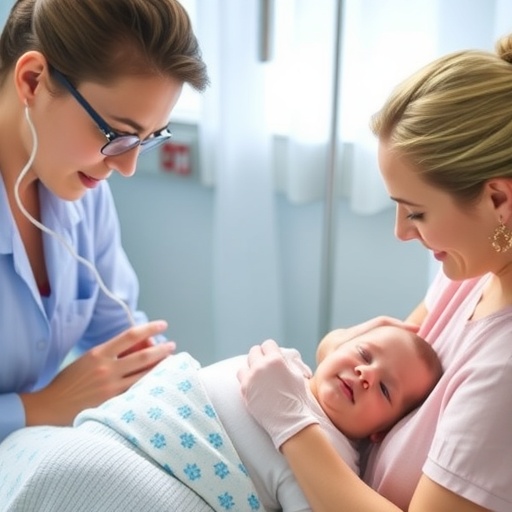In the realm of neonatal care, few challenges stand as persistently complex as the management of apnea in preterm infants. Despite decades of clinical practice and research, a standardized framework for defining and monitoring this condition remains elusive. Apnea, characterized by pauses in breathing lasting more than a few seconds, is alarmingly prevalent among preterm newborns, yet discrepancies in its clinical definition and the technological approaches adopted for its detection continue to hinder optimal medical interventions. A recent comprehensive scoping review led by Jeanne, Lv, Sénéchal, and colleagues, published in Pediatric Research, sheds critical light on the current landscape of apnea monitoring methods and definitions, triggering renewed conversation in the neonatal research community.
The review underscores a crucial gap: despite apnea’s prevalence in neonatal intensive care units (NICUs), there is no consensus on how to uniformly identify or monitor these episodes. Clinicians often rely on devices such as impedance pneumography, pulse oximetry, and capnography, but each method possesses unique characteristics, sensitivities, and limitations that influence detection reliability. The heterogeneity in usage complicates not only bedside decision-making but also the comparability of research outcomes, ultimately impacting the trajectory of evidence-based care for neonates.
Impedance pneumography, one of the classical monitoring techniques, measures chest wall movements to infer respiratory effort. Its widespread adoption in NICUs is due in part to its non-invasive nature and capacity for continuous monitoring. However, this method is sensitive to motion artifacts and may occasionally misinterpret other chest movements, leading to false positives or missed apnea episodes. The scoping review illuminates how such technical nuances contribute to varied apnea episode reporting across studies and settings.
Pulse oximetry, another cornerstone of apnea detection, works by tracking oxygen saturation in the blood, indirectly revealing respiratory events via desaturation episodes. While providing critical cardiovascular-oxygenation correlations, pulse oximetry often lags behind respiratory changes and can overlook brief but clinically relevant apneas. Additionally, the delay in saturation changes relative to respiratory pause onset limits its utility as an immediate apnea detector, emphasizing the need for complementary modalities.
Capnography, which measures exhaled carbon dioxide, reflects ventilatory status more directly but is less commonly employed in neonates due to technical challenges, including small tidal volumes and airway instrumentation issues. The review highlights emerging evidence suggesting that, with appropriate adaptation, capnography could enhance apnea monitoring accuracy, though it requires further validation in fragile preterm populations.
Central to the review’s findings is the lack of a universally accepted apnea definition within the neonatal literature. Variability exists not only regarding the minimum duration of respiratory pause to qualify as apnea, which ranges commonly between 10 to 20 seconds but also in qualifying clinical features such as associated bradycardia or desaturation events. This definitional inconsistency obstructs the development of standardized intervention thresholds and prognostic assessments, complicating caregiver responses and parental communication.
The clinical significance of apnea extends beyond the immediate respiratory disruption. Recurrent apneas can precipitate hypoxic injury with long-term neurodevelopmental consequences, including cognitive impairments and motor deficits. This underlines the urgency for accurate, timely, and clinically meaningful apnea detection. Understanding these sequelae, the review advocates for a unified apnea definition that incorporates physiological parameters beyond mere absence of breathing, integrating heart rate and oxygen saturation changes to capture the event’s true clinical impact.
Technological advancements, such as machine learning algorithms and multi-parameter monitors, represent innovative frontiers in apnea detection. The review touches on promising pilot studies employing artificial intelligence to analyze complex physiological signals, distinguishing true apnea events from artifacts with increasing precision. While these approaches offer hope for improved monitoring, they also highlight challenges in generalizability, regulatory approval, and workflow integration.
From a clinical workflow perspective, apnea monitoring protocols vary widely between institutions due to resource availability, staff training, and local practice culture. These disparities affect not only detection but also data interpretation and documentation, thereby influencing treatment decisions such as caffeine therapy initiation or respiratory support escalation. The scoping review emphasizes the need for standardized protocols aligned with a consensus apnea definition to harmonize care quality across NICUs globally.
Importantly, the review identifies gaps in the current literature—most studies focus on short-term apnea detection accuracy, with limited data on how monitoring strategies influence long-term neonatal outcomes. Furthermore, few investigations incorporate parental perspectives or address the psychological burden of apnea monitoring alarms, which can affect family-centered care practices and the neonatal environment.
Epidemiologically, apnea incidence correlates inversely with gestational age, presenting more frequently and severely in extremely preterm infants. The review catalogs this trend while cautioning against oversimplifying apnea risk stratification, calling for nuanced approaches that consider individual vulnerability alongside developmental maturation and comorbidities.
The review’s integrative approach, spanning multiple countries and clinical settings, reveals that apnea management remains an intricate challenge at the intersection of physiology, technology, and clinical judgment. It advocates collaborative efforts among clinicians, engineers, and researchers to refine apnea definitions, develop multimodal monitoring systems, and validate their clinical utility through large-scale longitudinal studies.
Neonatology’s future may see the establishment of global apnea monitoring standards, informed by consensus-driven definitions and bolstered by advanced sensor technologies. Such progress promises to enhance early intervention, minimize neurodevelopmental impairments, and improve survival outcomes for the world’s most vulnerable infants.
In conclusion, the scoping review by Jeanne, Lv, Sénéchal, and colleagues represents a pivotal step towards clarifying the currently fragmented terrain of apnea monitoring in preterm infants. By systematically cataloging definitions and detection methods, it paves the way for concerted efforts aimed at harmonizing clinical practice and fostering innovations in neonatal respiratory care. As apnea continues to challenge NICUs worldwide, this work calls for a unified framework that balances scientific rigor with compassionate clinical care—a mission vital to the health trajectory of preterm infants.
Subject of Research: Apnea monitoring and definition standardization in preterm infants
Article Title: Definitions and monitoring methods for apnea in preterm infants: a scoping review
Article References:
Jeanne, E., Lv, S., Sénéchal, E. et al. Definitions and monitoring methods for apnea in preterm infants: a scoping review. Pediatr Res (2025). https://doi.org/10.1038/s41390-025-04571-3
Image Credits: AI Generated
DOI: 19 November 2025




